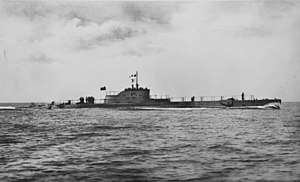Italian submarine Vettor Pisani
Vettor Pisani was the lead ship of her class of four submarines built for the Regia Marina (Royal Italian Navy) during the late 1920s. She was named after Vettor Pisani, a Venetian admiral. The submarine played a minor role in the Spanish Civil War of 1936–1939 supporting the Spanish Nationalists.
 Vettore Pisani on the surface | |
| History | |
|---|---|
| Name: | Vettor Pisani |
| Namesake: | Vettor Pisani |
| Builder: | Cantiere Navale Triestino, Trieste |
| Laid down: | 18 November 1925 |
| Launched: | 24 November 1927 |
| Completed: | 16 June 1929 |
| Stricken: | 23 March 1947 |
| Fate: | Scrapped |
| General characteristics | |
| Class and type: | Pisani-class submarine |
| Displacement: |
|
| Length: | 68.2 m (223 ft 9 in) |
| Beam: | 6.09 m (20 ft) |
| Draught: | 4.93 m (16 ft 2 in) |
| Installed power: | |
| Propulsion: |
|
| Speed: |
|
| Range: |
|
| Test depth: | 90 m (300 ft) |
| Complement: | 48 |
| Armament: |
|
Vettor Pisani briefly had Junio Valerio Borghese as commander during the Second World War. Due to her age, her usefulness was limited, and she saw no real service during the war. The submarine survived the war and was subsequently laid up on 23 March 1947.
Design and description

Designed in parallel with the Mameli-class submarines, the Pisani class was larger accommodate more fuel and give them more range. They displaced 880 metric tons (866 long tons) surfaced and 1,057 metric tons (1,040 long tons) submerged. The submarines were 68.2 meters (223 ft 9 in) long, had a beam of 6.09 meters (20 ft) and a draft of 4.93 meters (16 ft 2 in).[1] They had an operational diving depth of 90 meters (300 ft).[2] Their crew numbered 48 officers and enlisted men.[1]
For surface running, the boats were powered by two 1,500-brake-horsepower (1,119 kW) diesel engines, each driving one propeller shaft. When submerged each propeller was driven by a 550-horsepower (410 kW) electric motor. They could reach 15 knots (28 km/h; 17 mph) on the surface and 8.2 knots (15.2 km/h; 9.4 mph) underwater.[2] On the surface, the Pisani class had a range of 5,000 nautical miles (9,300 km; 5,800 mi) at 8 knots (15 km/h; 9.2 mph);[1] submerged, they had a range of 70 nmi (130 km; 81 mi) at 4 knots (7.4 km/h; 4.6 mph).[2]
The boats were armed with six 53.3-centimeter (21 in) torpedo tubes, four in the bow and two in the stern for which they carried a total of nine torpedoes. They were also armed with a single 102-millimeter (4 in) deck gun forward of the conning tower for combat on the surface. Their anti-aircraft armament consisted of two 13.2-millimeter (0.52 in) machine guns.[1]
Construction and career
Vettor Pisani was laid down by Cantiere Navale Triestino in their Trieste shipyard on 18 November 1925, launched on 24 November 1927, and completed on 16 June 1929.[3] During the Spanish Civil War, the submarine unsuccessfully attacked a ship during her patrol off Barcelona on 7–20 August 1937.[4]
Notes
- Chesneau, p. 307
- Bagnasco, p. 141
- Fraccaroli, p. 127
- Frank, p. 96
References
- Bagnasco, Erminio (1977). Submarines of World War Two. Annapolis, Maryland: Naval Institute Press. ISBN 0-87021-962-6.
- Brescia, Maurizio (2012). Mussolini's Navy: A Reference Guide to the Regina Marina 1930–45. Annapolis, Maryland: Naval Institute Press. ISBN 978-1-59114-544-8.
- Chesneau, Roger, ed. (1980). Conway's All the World's Fighting Ships 1922–1946. Greenwich, UK: Conway Maritime Press. ISBN 0-85177-146-7.
- Fraccaroli, Aldo (1968). Italian Warships of World War II. Shepperton, UK: Ian Allan. ISBN 0-7110-0002-6.
- Frank, Willard C., Jr. (1989). "Question 12/88". Warship International. XXVI (1): 95–97. ISSN 0043-0374.
- Rohwer, Jürgen (2005). Chronology of the War at Sea 1939–1945: The Naval History of World War Two (Third Revised ed.). Annapolis, Maryland: Naval Institute Press. ISBN 1-59114-119-2.